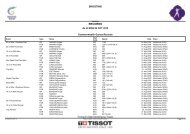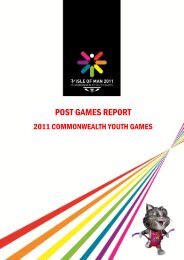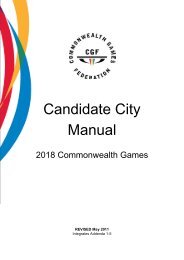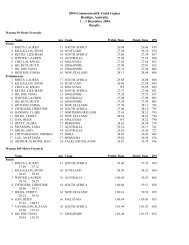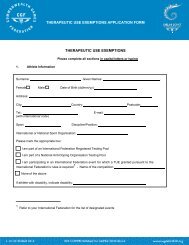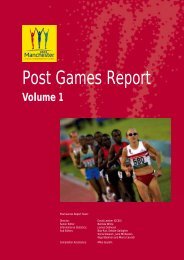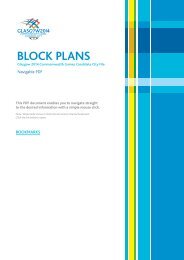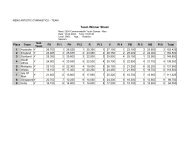Nutrition for Athletes - Commonwealth Games Federation
Nutrition for Athletes - Commonwealth Games Federation
Nutrition for Athletes - Commonwealth Games Federation
You also want an ePaper? Increase the reach of your titles
YUMPU automatically turns print PDFs into web optimized ePapers that Google loves.
athletes’ medical in<strong>for</strong>mationSpecial needs of theyoung athleteEvery child and adolescent around the worldshould have the opportunity to participate insport and should be encouraged to do so. Sportoffers the benefits of aerobic fitness, skilldevelopment and a team environment. Girls andboys can start practising and competing at anearly age, though the focus should be on funand on skills development rather than onper<strong>for</strong>mance. Nonetheless, most children arenaturally competitive and it would be a mistaketo suppress this instinct. Those with particulartalent may progress to serious training andcompetition, but others continue <strong>for</strong> reasons ofrecreation, fitness or social contact.Training issuesDepending on the age and calibre of the youngathlete, ‘training’ may range from the weeklyschool PE lesson to structured sessions at alocal club. The goals of training may range fromsimply having fun through to a progressiveprogram aimed at developing the skills andspecific fitness and physique required toprogress to serious competition. Talented youngathletes may be invited to train with another agegroup or with a senior squad, often in additionto their involvement with their age-group team.Competition issuesFor the youngest age groups, there should beno special need <strong>for</strong> any change to diet in thedays be<strong>for</strong>e competition or on competition dayitself. The main aims are to minimise the risk ofgastrointestinal upset and to avoid problemsof dehydration on hot days. It may be bestto avoid solid food <strong>for</strong> 2-3 hours be<strong>for</strong>ecompetition — the combination of exerciseand nerves can cause some gastric distress.Children can often be out in the sun <strong>for</strong>many hours on sports days, and adults shouldbe vigilant to ensure frequent application of suncream and be aware of any child who seemsto be having problems. Ample fluid should beavailable, and children may need to bereminded to take small amounts of drinksat regular intervals.Special issues and eating strategiesParents are often roped in to become thecoaches and trainers of age-group teams.They may accept these positions without anappreciation of the nutritional needs of the sportor young people, and without any resources toimplement an effective training and diet program.It is important that education resources are madeavailable to these coaches so that they can guideyoung athletes into good habits.<strong>Athletes</strong> should be encouraged to developgood nutritional habits at an early age.Adolescence is a time marked by an increasedindependence, and this extends to greaterfreedom of food choice and greater responsibility<strong>for</strong> food preparation. The promise of sportingsuccess may provide strong motivation todevelop good dietary practices. In<strong>for</strong>mation andthe example of good role models may help ayoung person to develop sound eating practicesin everyday (training) diets as well as thespecific preparation <strong>for</strong> competition.The physiology of children and adolescentsdiffers from that of adults in several ways. Themechanisms of thermoregulation are less22



